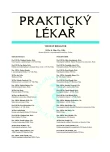Chronic wound treatment in old age under supervision of a geriatrician
Authors:
I. Doleželová; V. Šípková; V. Tomečková
Authors‘ workplace:
Primářka: MUDr. Ivana Doleželová
; Geriatrické oddělení
; Fakultní Thomayerova nemocnice s poliklinikou, Praha
; Ambulance pro hojení ran
Published in:
Prakt. Lék. 2009; 89(1): 33-39
Category:
Case Report
Overview
Chronic wounds are caused by heterogeneous factors. In old age the formation of chronic wounds and their healing are further modified by others factors, such as higher age, polymorbidity and the treatment of infected wounds (polypragmasia). The formation of chronic wounds makes itself more felt in old age rather than in middle age because of skin ageing, immunosenescence, vessel’s ageing and malnutrition. All these factors deteriorate skin quality and they make the skin less resistant to infection. A chronic wound is both a physical and psychological load for seniors. It is also a significant stress factor that induces anxiety and depression, thereby impairing the senior’s cognitive sufficiency and ability. The patient with a chronic wound remains in social isolation, which assists anxious depression and cognitive impairment. Case reports compare chronic wound formation, healing and treatment intervention in two patients with different ages, cognitive abilities, with different nutrition scores and mobility.
Key words:
chronic wound, physiological ageing, immunosenescence, cognitive dysfunction, disability.
Sources
1. Bartak, P., Stárnutí nemusí být povinné. Sanquist 2002, 20, s. 46. (On-line) Dostupné na: http:// www.sanquis.cz/index.php?linkID=art768.
2. Bartali, B., Frongillo, E.A., Bandinelli, S., Lauretani, F. Low nutrient intake is an essential component of frailty in older persons. J. Gerontol. A. Biol. Sci. Med. Sci. 2006, 61, p. 589-593.
3. Bulati, M., Pecllicano, M., Vasto, S., Colonna-Romano, G. Understanding ageing: biomedical and bioengineering approaches, the immunologic view. Immunity & Ageing 2008, 5, p. 9 [on-line]. Dostupné na http://www.immunityageing.com/content/ 5/1/9#IDATTFHW.
4. Janáková, A. Obecný úvod do problematiky hojení ran. Čtvrtletní noviny 2006/1. [on-line] Dostupný na www: http://www.nutriciamedical.cz/ download/noviny.pdf.
5. Kalvach, Z., Zadák, Z., Jirák, R. a kol. Geriatrie a gerontologie. Praha: Grada Publishing, 2004.
6. Miller, J. Lower limb ulcers: investigation and management. Power point presentation(2007). [on-line] Dostupný na www: http://www.surgeons. org/Content/NavigationMenu/WhoWeAre/Regions/QLD/071120_JMiller.pdf.
7. Kopecký, O., Krejsek, J. Stárnutí a imunita. Alergie –Tigis. [on-line] Dostupný na www http://www.tigis.cz/alergie/aler303/09.htm.
8. Košťálová, M., Košťál, M. Menopause and aging of the skin. Gynekolog 2007/3. [on-line]. Dostupný na www:http://www.gyne.cz/clanky/2007/307cll.htm.
9. Michelon, E., Blaum, C., Richard, D., Semba, R.D. Vitamin and carotenoid status in older women: associations with the frailty syndrome. J. Gerontol. A. Biol. Sci. Med. Sci. 2006, 61, p. 600-607. Dostupný na www: http://biomed.gerontologyjournals. org/cgi/content/abstract/61/6/600.
10. Musil, D. Chronická žilní insuficience – současný stav poznání. Interní medicína pro praxi 2003, 6, s. 276.
11. Nouza, M., Nouza, K. Stárnutí a imunita. Sanquis 2005, 42, s. 18.
12. Thompson, Ch., Furman, M.P. Nutritiens and wound healing: still searching for the magic bullet. Nutrition in Clinical Practice 2005, 20, 3, p. 331-347.
13. Topinková, E. Geriatrie pro praxi. Praha: Galén, 2005.
14. Semba, R.D., Bartali, B., Zhou, J., Blaum, C. Low serum micronutrient concentrations predict frailty among older women living in the community. J. Gerontol. A. Biol. Sci. Med. Sci. 2006, 61, p. 594-599. Dostupný na www: http://biomed.gerontologyjournals.org/cgi/content/abstract/61/6/594.
15. Syndrom diabetické nohy. Rány.cz 2006. [on-line]
Dostupný na www: http://www.rany.cz/etiologie-diabet-noha.htm.
16. Vocílková, A. Scénář, podle kterého kůže stárne. [on-line] Dostupný na www: http://www.f-cosmeceuticals.cz/cz/poradna_1.html?keepThis=true&TB_iframe=true&height=545&width=551.
17. Žuffová-Kunčová, B. Bércový vřed. Med. Pro praxi 2007, 5, s. 228-232.
Labels
General practitioner for children and adolescents General practitioner for adultsArticle was published in
General Practitioner

2009 Issue 1
- Memantine Eases Daily Life for Patients and Caregivers
- Metamizole vs. Tramadol in Postoperative Analgesia
- Metamizole at a Glance and in Practice – Effective Non-Opioid Analgesic for All Ages
- Memantine in Dementia Therapy – Current Findings and Possible Future Applications
- What Effect Can Be Expected from Limosilactobacillus reuteri in Mucositis and Peri-Implantitis?
Most read in this issue
- Chronic wound treatment in old age under supervision of a geriatrician
- Nutritional care in premature babies after hospital discharge
- Current possibilities for the treatment of patients with epilepsy.
- Estimation of renal function changes on the basis of serum creatinine levels – potential and limitations
